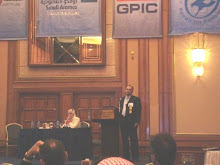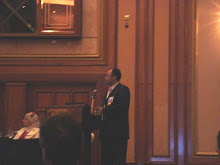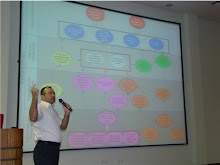We are going to introduce some practices that, when adequately implemented, can increase probability of successful project completion. They will be presented as:
- Being tested on a project we have recently performed
- Followed by recommended Post Project Reviews
--------------------------------------------------------------------
Introduce RMMM
After performing the assessment of current and target maturity levels for the project, maturity gaps were identified and strategies developed to leverage them.
In this aspect, we used the RMMM (Relationship Management Maturity Model) that served in aligning IT and business units of that project (Martin et al।, 2006). It did this via introducing a mechanism of an interpretive approach to knowledge processes between business and IT; then defining the tasks of the “Relationship Managers” as facilitators of knowledge sharing and measuring the maturity of the business/IT relation. The RMMM was furthermore used to identify problematic issues and develop processes to address them.
Post Project Review: We found that RMMM and relationship managers were effective; more alignment, open communication were evident and IT deliverables enabled realisation of business objectives. We recommend integrating this practice into our core processes for future solutions.
About The Author

- Eng. Samer el Barakeh, MPM, PMP
- Samer el Barakeh was born in Lebanon, 1973. He completed his Bachelor in Engineering-CCE at Beirut Arab University-Lebanon in 1996 with honours. Samer was granted Masters Degree in Project Management (MPM) from the University of Sydney-Australia with honours. He also gained the Project Management Professional (PMP) Credential from The Project Management Institute (PMI). Samer is a member of the Order of Architects and Engineers in Lebanon since 1996, The Project Management Institute (PMI), Arabian Gulf Chapter (AGC-PMI) and Lebanon Chapter-PMI. During his 13 years of professional experience in Lebanon, Australia and Saudi Arabia, Samer held many positions among them: Telecommunication Site Engineer, Site Manager, Low Current Service Head, and he is currently Senior Systems Analyst at the General Project Construction Division. Samer is a Project Management Consultant and Training Provider for universal organizations like Business Management Consultants (USA) www.bmc-online.com and PMCTQuest (Canada) www.pmctquest.com Samer is a Registered Training Provider for Project Management Professional (PMP), and he provides training in Program Management, Portfolio Management,PMO...
Select a topic to view content
- A comparison between PMBOK and Prince2 Methodologies and reflection on case study examples (1)
- ABC to Avoid Project Failure (1)
- Business Case and Quantitative Benefits (1)
- Do we need more 'Planners' ? (1)
- Fasilitator in Partnering-A Coincise Shot (1)
- How to Ensure Stratgic Alignment of Our Projects? (1)
- Individual Dissimilarity and Team Work (1)
- Knowledge Management (1)
- Maturity Models-The Pros and Cons (1)
- Organizational Advantages from Partnering (1)
- Organizational Maturity: Lets Head Upwards... (1)
- Organizational Strategy and Project Alignement (1)
- Practical Solutions 1 of 6: Introduce RMMM (1)
- Practical Solutions 2 of 6: Facilitate Change to Perk up Maturity (1)
- Practical Solutions 3 of 6: Leverage Organisational Culture Barrier (1)
- Practical Solutions 4 of 6: Organisational Cultural Alignment (1)
- Practical Solutions 5 of 6: Defining a Unified Decision Making Tool (1)
- Practical Solutions 6 of 6: Understanding The Paradox of Control (1)
- Programme Management to Implement Strategy (1)
- Project Management and Construction Management (1)
- Project Managers relocated before Proper Project Closure and Learning Lessons (1)
- Project Managers' Power (1)
- Strategic Planning (1)
- Successful Project Management Office-PMO (1)
- System Thinking: Archetypes at Work... (1)
- The Partnering Change Process (1)
- The Upper Hand… Leadership skills or Processes? (1)
- Thinking about change needed? Maybe you should be more ‘worried’ about how to make it real (1)
- Vision Mission and Objectives What and Why? (1)
- What is meant by Portfolio and Programme Management (1)
- Why Partnering in Organizations? (1)
July 8, 2007
Practical Solutions 1 of 6: Introduce RMMM
Posted by
Eng. Samer el Barakeh, MPM, PMP
at
8:00 PM
3
comments
![]()
![]()
July 7, 2007
Practical Solutions 2 of 6: Facilitate Change to Perk up Maturity
Facilitate Change to Perk up Maturity
With the many remaining gaps identified, the challenge of establishing a roadmap to move forward and leverage these gaps emerged. To do so, changes to project’s processes had to be developed and implemented.
In that case, as in many organizations, we were at different maturity levels in different Areas. Another implication introduced then was that immaturity in a knowledge area can affect success in others areas even if they were of high maturity levels (Duffy J., 2001).
A resolution to this challenge was to adopt IDC’s series of maturity models (International Data Corporation, Canada) where each maturity model (MM) is focused on the change associated with achieving excellence in managing key strategic business issues। The first four address the following issues:
- Customer Centricity;
- E-business Resilience;
- IT/Business Alignment (little work has to be done here as we have already addressed this gap by CMMM);
- IT Value, Metrics and Measurement.

Figure: Roadmap to Plan change, adopted from Duffy J., 2001
Post Project Review: The process had some shortages due to sensitivity that emerged during the self assessment process along with considerable time consumption along the implementation steps. We recommend using it only in case of ongoing developments rather than short span projects.
Posted by
Eng. Samer el Barakeh, MPM, PMP
at
8:25 PM
0
comments
![]()
![]()
Labels: Practical Solutions 2 of 6: Facilitate Change to Perk up Maturity
July 6, 2007
Practical Solutions 3 of 6: Leverage Organisational Culture Barrier
Organisational Culture Barrier
Organisational culture is in many cases a roadblock to project development as shown in figure below (Peppard and Ward, 1999). Consequently, other PM practices have to be developed in Parallel to and integrating with the RMMM in order to eliminate such a roadblock (Martin et al., 2006). 
We experienced a very effective strategy to leverage this roadblock by promoting a “Community of Practice” between the business and IT Units; where Wenger et al। (2002) describes it as a group of people that are bound together informally through sharing expertise and enthusiasm to achieve a target. CoP’s are driven by values, knowledge and know-how in contrast to traditional teams that are driven by deliverables and defined tasks. We witnessed efficient circulation of knowledge through the organization and a demolition of barriers between people and departments (Yang, 2004; Davenport and Prusak, 2004) as shown in figure below.
 Figure: Closing the business-IT gap adopted from Martin et al।, 2006।
Figure: Closing the business-IT gap adopted from Martin et al।, 2006।Post Project Review: Multi cultural teams with diversified backgrounds were more common and with CoP, it was not easy to build trust and rapport in a short time। We recommend more team building activities at the outset and developing smaller groups for less diversity.
Posted by
Eng. Samer el Barakeh, MPM, PMP
at
8:52 PM
0
comments
![]()
![]()
Labels: Practical Solutions 3 of 6: Leverage Organisational Culture Barrier
July 5, 2007
Practical Solutions 4 of 6: Organisational Cultural Alignment
A good, ample practice we sighted was that presented by Thompson and Sanders (1998); first, they identified different levels of involvement that are possible within partnerships and which they referred to as competition, cooperation, collaboration and coalescence. Then they presented a framework whereby differences and similarities in the cultures of partnering groups can be assessed and evaluated as shown in the following figure. The red line we drew identifies those cultural indicators where improvement strategies are required in order to increase the level of maturity and/or alignment and hence the probabilities of success for the partnership arrangement
 Figure 9: The Cultural maturity-Alignment
Figure 9: The Cultural maturity-Alignment
Posted by
Eng. Samer el Barakeh, MPM, PMP
at
6:29 PM
0
comments
![]()
![]()
Labels: Practical Solutions 4 of 6: Organisational Cultural Alignment
July 4, 2007
Practical Solutions 5 of 6: Defining a Unified Decision Making Tool
The next confront that faced our Project was to provide business and project managers with an open standard that can help them identify priorities and take decisions in a conscience way. To do so, a unified decision making tool was adopted. It reduced data at hand and enabled trouble-free reporting on performance. The Tool was based upon project measurement capabilities that already existed (Sevick, 2005).
A good example of the unified tool is the APdex formula (Application Performance Index) which sorts the assessment of end user satisfaction in an IT development into three categories:
- No of Satisfied users,
- No of tolerating users,
- No of frustrated users
The Apdex index can then be calculated using the following equation:
APdex = (Satisfied + (tolerating/2))/Total Samples
Developing this index for IT tasks provided senior management with common way to compare performance across all applications. We were then able to identify those practices that need improvements and gauge the effectiveness of improvement practices as well. However we had to factor in the importance of the process itself from a business perspective along with the unified Index.
Posted by
Eng. Samer el Barakeh, MPM, PMP
at
6:51 PM
0
comments
![]()
![]()
Labels: Practical Solutions 5 of 6: Defining a Unified Decision Making Tool
July 1, 2007
Practical Solutions 6 of 6: Understanding The Paradox of Control
Project’s control is a challenge. In our Project, we developed a rigid control process with metrics scattered over all project processes. Corrective actions were implemented whenever an indicator slipped outside accepted boundary. However, there was a decrease in sponsor’s satisfaction along the way. We performed a system thinking analysis to identify root causes and find best solutions as shown below Post Project Review: We learned that Project Manager must be vigilant in controlling the project outcomes in a prevailing climate of change and uncertainty.
Post Project Review: We learned that Project Manager must be vigilant in controlling the project outcomes in a prevailing climate of change and uncertainty.
While those affect both the Project Manager and other stakeholders, it was erroneous to expect the project to maintain delivering within agreed boundaries (STCQ) where predictable deviations from the plan are viewed by senior stakeholders as “out of control”.
The “zone” of middle management is bounded from the lower and upper sides by project managers and senior stakeholders respectively (shown in figure below). Project managers sense strategic directions/change by interacting with this zone. The prevailing assumption that this zone will always react to strategic management stimuli in the same way was here questioned! The reason to which is that the only certainty in the “zone” is unpredictability; Strategic and senior managers were made aware of this fact for future projects.
Project managers sense strategic directions/change by interacting with this zone. The prevailing assumption that this zone will always react to strategic management stimuli in the same way was here questioned! The reason to which is that the only certainty in the “zone” is unpredictability; Strategic and senior managers were made aware of this fact for future projects.
Controls comprise the craft of maintaining time, cost and quality by means of project control processes (process flow diagrams, responsibility activity matrix, QM, assessment criteria, KPIs and the like) along with the art of managing relationships with stakeholders and the forces they exerted in the “zone” (Theilen, 1999).
As a result, our Project managers gained a broader understanding of the three dimensions of control (figure below) and they comprehended that the “Control Process” is closely related to other Management Processes, like Stakeholder Management. 
Posted by
Eng. Samer el Barakeh, MPM, PMP
at
6:58 PM
0
comments
![]()
![]()
Labels: Practical Solutions 6 of 6: Understanding The Paradox of Control















